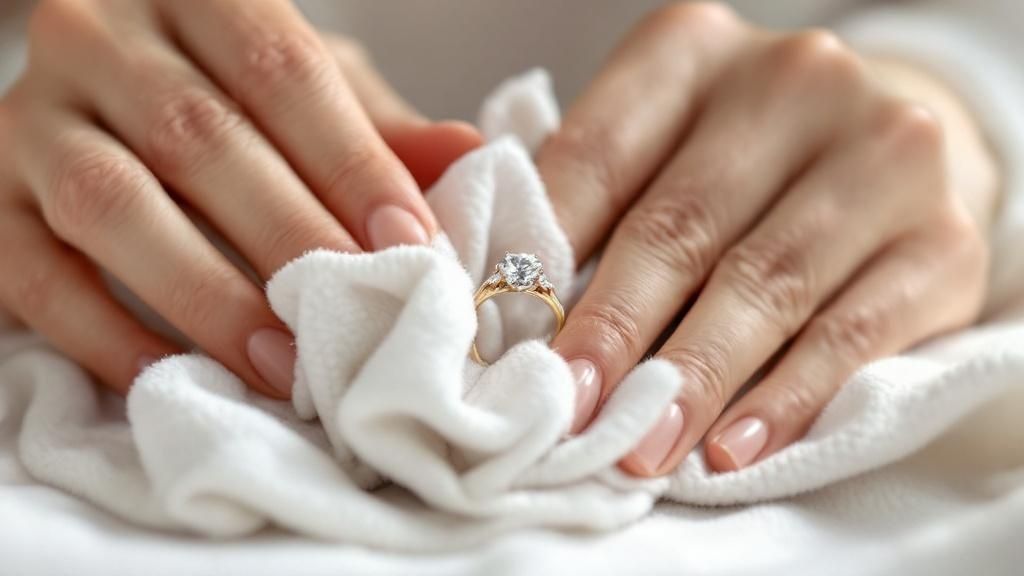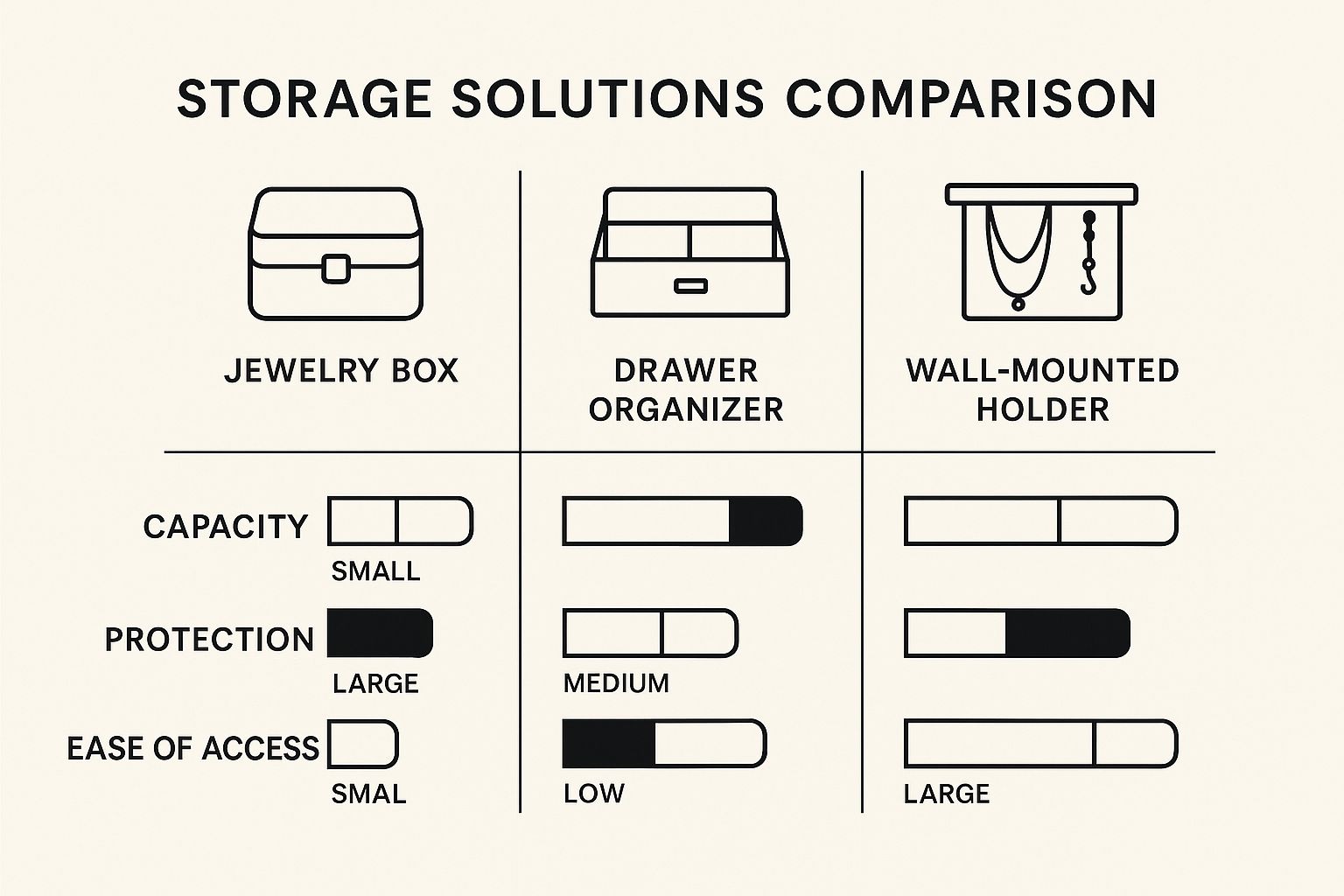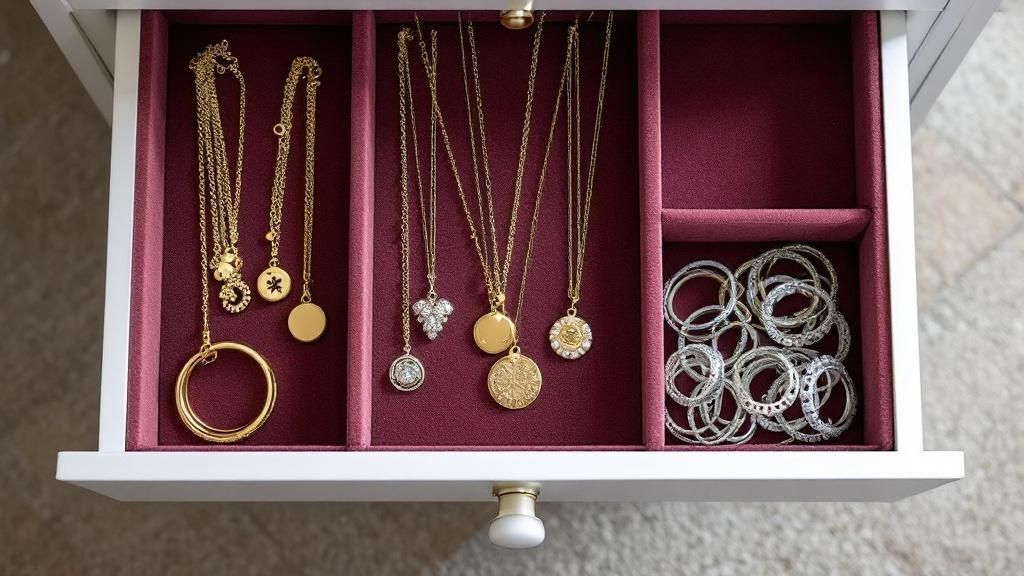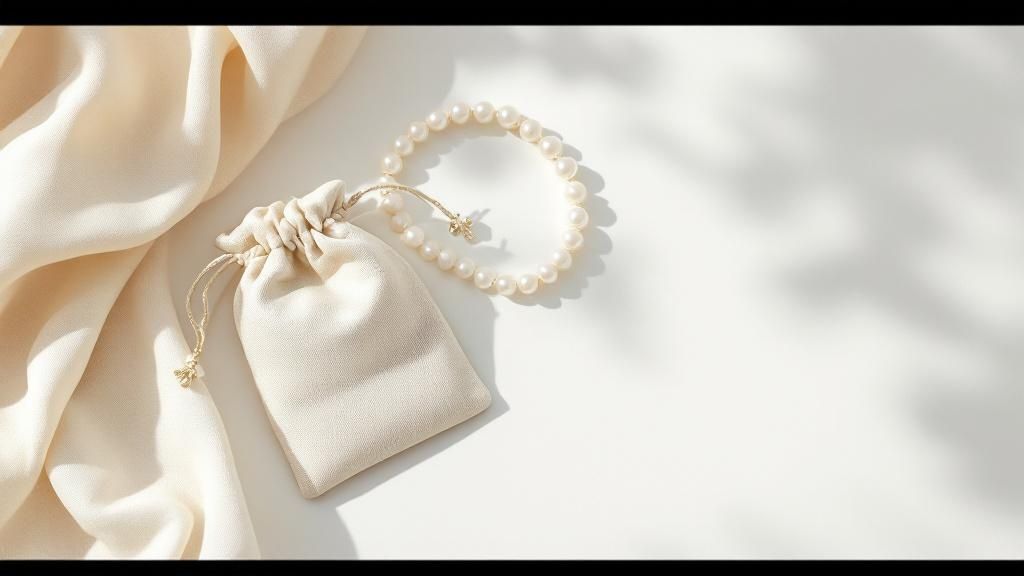How to Store Fine Jewelry: Expert Protection Guide
- seanmawhinney
- Jun 2
- 12 min read
Understanding Why Proper Storage Makes or Breaks Your Investment

Fine jewelry is more than a fashionable accessory; it's a tangible investment. But without proper care and storage, this investment can depreciate quickly. Professional appraisers have seen firsthand how seemingly small storage mistakes can lead to substantial financial losses. This highlights the need to understand how storage truly impacts the longevity and value of your precious pieces.
One often overlooked aspect is the effect of environmental factors. Fluctuations in humidity and temperature, for example, can damage various metals and gemstones. High humidity can tarnish silver, and extreme temperature swings can fracture certain gemstones. Simply putting your jewelry in a drawer isn't enough for long-term preservation.
The materials used in your jewelry also determine the best storage methods. Delicate pieces, like pearl necklaces, require different care than a durable gold bracelet. Storing these items together can cause scratches, chips, or other damage, ultimately decreasing their value. Understanding the nuances of how different materials interact is key to proper jewelry storage.
The broader jewelry market also influences how fine jewelry is stored and organized. In 2023, the global jewelry market reached a value of USD 353.26 billion, and it's projected to grow 4.7% between 2024 and 2030. This increasing demand, driven by the use of precious metals like the 2,150+ metric tons of gold used in jewelry in 2023, requires secure and organized storage. As consumers acquire more jewelry, proper storage becomes essential to protect their investments. For more detailed statistics, see this report from Grand View Research.
The Hidden Costs of Improper Storage
Improper storage often leads to hidden costs that can significantly impact your collection's value. These costs go beyond repairs for obvious damage. Tarnished silver might need professional cleaning, and a scratched gemstone could require repolishing — both adding to your expenses.
Furthermore, improper storage can void or restrict insurance coverage. Many insurance policies have specific storage requirements for full coverage. If you neglect proper storage, you could be financially liable for losses from theft, damage, or other unforeseen circumstances. Knowing these potential consequences underscores the importance of investing in the right storage solutions.
Building The Perfect Storage Environment With The Right Materials
Not all storage solutions are created equal. While some methods may appear convenient, they could be quietly damaging your precious jewelry. Understanding which materials offer genuine protection, and which pose a hidden risk, is essential for preserving your collection.
Choosing The Right Materials
Through research into professional storage practices and consultation with conservation experts, we’ve uncovered the ideal conditions for various jewelry types. Surprisingly, certain fabrics can tarnish silver faster than air exposure, and some common household items are secretly detrimental to your precious pieces. Understanding material science is key to proper jewelry storage.
Acid-Free Materials: Line your jewelry boxes with acid-free fabrics like velvet, silk, or untreated cotton. This prevents chemical reactions that can tarnish or discolor metals.
Compartments and Dividers: Individual compartments and dividers within your storage prevent scratches and tangles. They also help organize your jewelry by type, making it easier to find what you need.
Anti-Tarnish Fabric: Specialized anti-tarnish cloths or bags, often embedded with silver or copper ions, absorb sulfur compounds in the air. These are particularly beneficial for silver jewelry, slowing down the tarnishing process.
You might be interested in: How to master jewelry storage.
Considering Capacity, Protection, and Accessibility

The infographic above compares three common storage options: jewelry boxes, drawer organizers, and wall-mounted holders. Each offers a different balance of capacity, protection, and accessibility. Jewelry boxes offer the best protection, while drawer organizers maximize capacity, and wall-mounted holders prioritize easy access. The best choice depends on your collection size, the value of your pieces, and your personal preferences.
Speaking of storage solutions, the jewelry organizer market is experiencing significant growth. Projected to expand from USD 29.6 billion in 2025 to USD 72.5 billion by 2035, it boasts a CAGR of 8.5%. This growth is driven by the increasing need for efficient storage, the popularity of home organization, and rising jewelry ownership. Innovations in space-saving design and anti-tarnish materials are further propelling this market expansion. Learn more about the jewelry organizer market.
To help you choose the best storage materials, let's take a look at the following table:
Best Storage Materials For Different Jewelry Types: Comparison of storage materials and their suitability for various fine jewelry pieces including gold, silver, pearls, and gemstones.
Jewelry Type | Recommended Material | Why It Works | What To Avoid |
|---|---|---|---|
Gold | Soft, lined compartments (velvet, silk) | Prevents scratches and reactions | Cardboard, untreated wood |
Silver | Anti-tarnish bags or cloth, airtight containers | Prevents tarnish and oxidation | Cardboard, wood, plastic bags |
Pearls | Silk or soft cotton pouches, individual compartments | Prevents scratching and absorbs moisture | Plastic bags, direct contact with other jewelry |
Gemstones | Soft padded compartments, individual boxes | Protects against chipping and scratching | Harsh chemicals, extreme temperatures |
This table summarizes the optimal storage materials for different jewelry types. Using the right materials protects your jewelry from damage and preserves its beauty.
Climate Control For Optimal Preservation
You don't need a museum to create ideal storage conditions. By controlling humidity, temperature, and light exposure, you can significantly extend the lifespan of your jewelry.
Humidity Control: Too much humidity accelerates tarnishing, while extreme dryness can damage certain gemstones. Silica gel packets in your jewelry box help absorb excess moisture.
Temperature Stability: Avoid temperature fluctuations, like those found in attics or near heating vents. These changes can weaken clasps and even crack some gems.
Light Exposure: Direct sunlight can fade gemstones. Store your jewelry in a cool, dark place to preserve its color and brilliance.
By following these simple principles, you can protect your investment and ensure your cherished pieces remain beautiful for years to come.
Professional Storage Solutions That Actually Protect High-Value Pieces

Protecting valuable jewelry requires more than simple storage boxes. When your collection represents a significant investment, professional-grade solutions are essential. This means understanding key factors like security, climate control, and accessibility to truly preserve and protect your high-value pieces.
Luxury Safes: Beyond Marketing Hype
Not all safes are created equal. While many safes boast impressive features, it's crucial to distinguish between genuine benefits and marketing tactics. Fire resistance ratings are a primary concern. Look for safes certified by reputable organizations, ensuring they can withstand high temperatures for extended durations.
Waterproofing is another critical feature for protection against floods or water damage. This is particularly important for safeguarding accompanying documents like appraisals or certificates of authenticity.
Some high-end safes offer advanced access controls, such as biometric fingerprint scanners or dual-key systems. These features enhance security without compromising convenience, allowing quick access for frequently worn items while maintaining overall protection. However, balance these features with practical accessibility. A safe that’s too difficult to use regularly may discourage proper storage altogether.
This connects to the growth in luxury jewelry sales. The global luxury jewelry market, valued at USD 48.97 billion in 2023, is projected to reach USD 97.05 billion by 2032, growing at a CAGR of 7.90%. This growth highlights the increasing demand for secure storage solutions designed for high-value jewelry. Learn more from Straits Research.
Climate-Controlled Systems: Museum-Quality Preservation
For truly invaluable collections, consider climate-controlled systems. These advanced solutions replicate the controlled environments found in museums, protecting jewelry from humidity, temperature fluctuations, and damaging light. These systems create a microclimate ideal for long-term preservation.
Insurance Implications: Protecting Your Investment
Proper storage isn't just about physical security; it significantly impacts insurance. Insurers often require specific storage measures for high-value items. Investing in professional-grade storage can potentially reduce insurance premiums and increase coverage options.
This means better protection in case of theft, damage, or other unforeseen events. Furthermore, insurers often consider your security measures when evaluating claims, emphasizing the link between proper storage and financial security.
Smart Organization Systems That Prevent Damage While Maximizing Access
Effective jewelry storage goes beyond simple protection. It's about easy access, enabling you to quickly find and enjoy your pieces. A well-organized system prevents damage like tangled necklaces and scratched pendants, eliminating the frustration of searching for the right earring.
Compartmentalization: A Place for Everything
Professional organizers, particularly those specializing in luxury items, stress the importance of compartmentalization. This prevents pieces from rubbing together, minimizing scratches and tangles. Consider divided drawers, individual boxes inside a larger jewelry chest, or even hanging organizers with separate pockets. The ideal method depends on the size and type of jewelry within your collection.
Rotation Systems and Inventory Management
A rotation system is beneficial for frequently worn jewelry. Designate a specific storage area for everyday pieces, making them easy to swap while keeping the rest of your collection safely stored. Maintaining a jewelry inventory, whether a simple spreadsheet or photographs, prevents loss and simplifies insurance claims.
Categorization: Making it Work for You
Jewelry organization isn't one-size-fits-all. The best system suits your lifestyle. Categorize your jewelry logically, perhaps by metal type, gemstone, occasion, or color. This allows you to find items easily without disrupting the entire system. For instance, separating sterling silver from gold prevents cross-contamination and tarnish.
Designated Spaces and Long-Term Organization
Look beyond a traditional jewelry box. Create designated spaces for jewelry storage within your home. This might be a dedicated drawer, a closet section, or a secure cabinet. This keeps jewelry from being scattered, reducing the risk of damage or loss.
For long-term organization, choose a system that can expand with your collection. Modular storage solutions are ideal, allowing you to add units as needed. This avoids constant reorganization and provides lasting protection for your valuable pieces. Remember, jewelry organization is an ongoing process. Regularly assess and adjust your system to accommodate new pieces and changing needs, preventing it from becoming cluttered over time.
Avoiding Expensive Mistakes That Destroy Fine Jewelry

Even with the best intentions, improper storage can damage fine jewelry. This section unveils common mistakes that can cost thousands in repairs or replacements, offering clear guidance on how to avoid them. Some commonly used storage methods, while seemingly harmless, can accelerate tarnishing and deterioration.
Many everyday household items can surprisingly damage precious metals and stones. Understanding these potential pitfalls is the first step in preserving your valuable collection.
Common Storage Mistakes and Their Impact
Improper storage isn't always obvious. What seems like a safe storage solution can actually be causing invisible damage. This can range from chemical reactions that discolor gold to physical damage from incorrect cushioning. Learning to identify these mistakes is crucial.
Storing jewelry together: This can lead to scratching, especially for softer metals and gemstones. For instance, a diamond ring rubbing against a gold bracelet can result in scratches, necessitating costly repairs.
Using the wrong materials: Cardboard boxes and some plastics contain chemicals that can tarnish metals and dull gemstones. Over time, this can significantly impact the brilliance and value of your pieces.
Exposing jewelry to extreme temperatures or humidity: High temperatures, humidity, or direct sunlight can weaken clasps, crack gems, and accelerate tarnishing. Leaving jewelry near a heating vent is a common example of this damaging practice.
Neglecting regular cleaning and inspection: Dirt and grime can build up, causing corrosion. Regular inspections can also reveal early signs of damage, allowing for timely and less costly intervention.
Learn more in our article about how to prevent jewelry from tarnishing.
The following table summarizes some frequent storage mistakes, their potential consequences, estimated repair costs, and effective prevention strategies.
Common Storage Mistakes And Their Solutions: Overview of frequent jewelry storage errors, their potential damage costs, and proven prevention methods
Storage Mistake | Potential Damage | Estimated Repair Cost | Prevention Method |
|---|---|---|---|
Storing jewelry together | Scratches, tangling | $50 - $500+ | Individual pouches or compartments |
Using cardboard or certain plastics | Tarnishing, discoloration | $50 - $200+ | Acid-free fabrics, anti-tarnish cloths |
Exposure to extreme temperatures or humidity | Cracked gems, weakened clasps | $100 - $1000+ | Stable environment, avoid direct sunlight |
Neglecting regular cleaning | Corrosion, grime buildup | $25 - $100+ | Regular cleaning and inspection |
This table highlights the importance of proactive prevention. While the estimated repair costs can vary depending on the severity of the damage and the specific piece of jewelry, the potential for financial loss underscores the value of correct storage practices.
Prevention Methods That Protect Your Investment
Preventing these expensive mistakes is straightforward. Simple changes in how you store fine jewelry can make a world of difference in preserving its condition and value.
Use individual pouches or compartments: This prevents items from rubbing against each other and causing scratches.
Choose the right materials: Opt for acid-free fabrics, anti-tarnish cloths, and airtight containers to create a protective barrier.
Maintain a stable environment: Store your jewelry in a cool, dark, and dry location, away from extreme temperatures, humidity, and direct sunlight.
Clean and inspect regularly: This allows you to catch and address any potential issues early on, preventing them from escalating into major problems.
Understanding the True Stakes: Repair vs. Replacement
It’s crucial to understand the financial implications of damage. Sometimes, the cost of repair exceeds the replacement value. Knowing the potential costs associated with different types of damage allows you to make informed decisions and prioritize your prevention efforts. This emphasizes the importance of proper storage in maintaining the longevity and value of your jewelry collection.
Daily Care Habits That Make Storage Actually Effective
Proper storage of fine jewelry doesn't begin when you put it away. It starts with simple, daily habits that are key to maintaining its beauty and value. These routines not only prepare your pieces for safekeeping but also prevent future issues that can dull their shine and decrease their worth.
Cleaning: Gentle Care for Lasting Beauty
Knowing how to clean different materials safely is essential. Some cleaning methods might cause hidden damage over time, affecting the brilliance of your jewelry. For instance, harsh chemicals can harm delicate pearls, and abrasive cleaners might scratch gold. Learn how to master jewelry cleaning at home. Understanding the difference between safe and harmful cleaning practices is crucial for preserving your jewelry’s value. Also, removing makeup, lotions, and pollutants before storage is vital. These substances can react with metals and stones, causing tarnish and discoloration.
Handling and Inspection: Preventing Micro-Damage
How you handle your jewelry every day greatly affects its long-term condition. Avoid tossing pieces carelessly into a dish or bag, as this can cause scratches, tangles, and even breakage. Instead, gently place each item in its designated storage location. This prevents small, almost invisible damage that can add up over time. Also, quick inspections before storing your jewelry can help you find loose stones, broken clasps, or other issues early. Addressing these small problems immediately can prevent bigger, more costly repairs down the line.
Establishing a Routine: Realistic and Sustainable Practices
Creating a sustainable routine is important for anyone who wears jewelry regularly. How often you clean and inspect your jewelry depends on how often you wear it. For everyday pieces, a quick wipe with a soft cloth after each use and a weekly inspection are good habits. For jewelry worn less often, cleaning and inspecting it before and after each wear is recommended. This makes sure that any potential problems are addressed before they get worse. Integrating these simple steps into your daily routine significantly prolongs the life of your fine jewelry, keeping it beautiful and valuable for years. Think of it like regular car maintenance—small, consistent efforts prevent major issues later. Creating realistic schedules based on how much jewelry you have and how often you wear it helps make these practices manageable and ensures maximum protection.
Key Takeaways For Bulletproof Jewelry Protection
This section offers a practical action plan for effectively storing your jewelry. We'll address common storage challenges, offering solutions for various budgets and collection sizes. From practical steps and troubleshooting advice to key success indicators, you'll find everything you need to protect your valuable collection.
Essential Materials and Organization
Investing in high-quality materials is the first step. Choose acid-free fabrics like velvet, silk, or untreated cotton to line your jewelry boxes. This prevents chemical reactions that lead to tarnish. Anti-tarnish bags or cloths are especially important for silver pieces.
Keeping your collection organized is also crucial. Compartmentalization, using dividers and individual compartments, prevents scratches and tangles. This also makes it easier to organize your jewelry by type or occasion.
Finally, environmental control plays a significant role. Maintain stable temperature and humidity levels. Silica gel packets can absorb excess moisture and help prevent tarnish. Avoid storing jewelry near heat or in direct sunlight.
Choosing the Right Storage Solution
The ideal storage method depends on your specific needs. Here are some options to consider:
Jewelry Boxes: Excellent protection and organization for smaller collections.
Drawer Organizers: Maximize space and suit larger collections but offer less protection.
Wall-Mounted Holders: Prioritize accessibility for frequently worn items, but provide minimal protection.
Safes: Offer the highest security for valuable pieces, protecting against theft, fire, and water damage. Climate-controlled safes provide ultimate protection for priceless collections.
Daily Habits for Long-Term Protection
Developing good habits is key to preserving your jewelry. Regular cleaning, using appropriate methods for different materials, is essential. Remove makeup or lotions before storing your jewelry.
Handling with care also makes a difference. Avoid tossing jewelry carelessly. Gently place each piece in its designated spot to prevent damage.
Regular inspections are crucial. Check for loose stones, broken clasps, or other damage. Addressing minor issues promptly prevents more costly repairs down the line.
Evaluating Your Current Setup
Take a moment to assess your current jewelry storage. A few key questions can reveal areas for improvement:
Material Check: Are your current materials potentially harming your jewelry? Replace cardboard and plastic with acid-free options.
Organization Assessment: Is your current setup disorganized? Implement compartmentalization and categorization systems.
Environmental Control: Is your jewelry stored in a stable environment? Consider temperature, humidity, and light exposure.
Security Measures: Is your valuable jewelry adequately protected? Evaluate the need for a safe or other security measures.
By implementing these takeaways, you’ll transform your jewelry storage into a system that actively protects your investment. Proper storage preserves the beauty and value of your cherished pieces for years to come.
Ready to upgrade your jewelry storage? Explore Panther De Luxe Shop for premium solutions designed for discerning collectors. Discover the perfect storage solution at Panther De Luxe Shop.

Comments